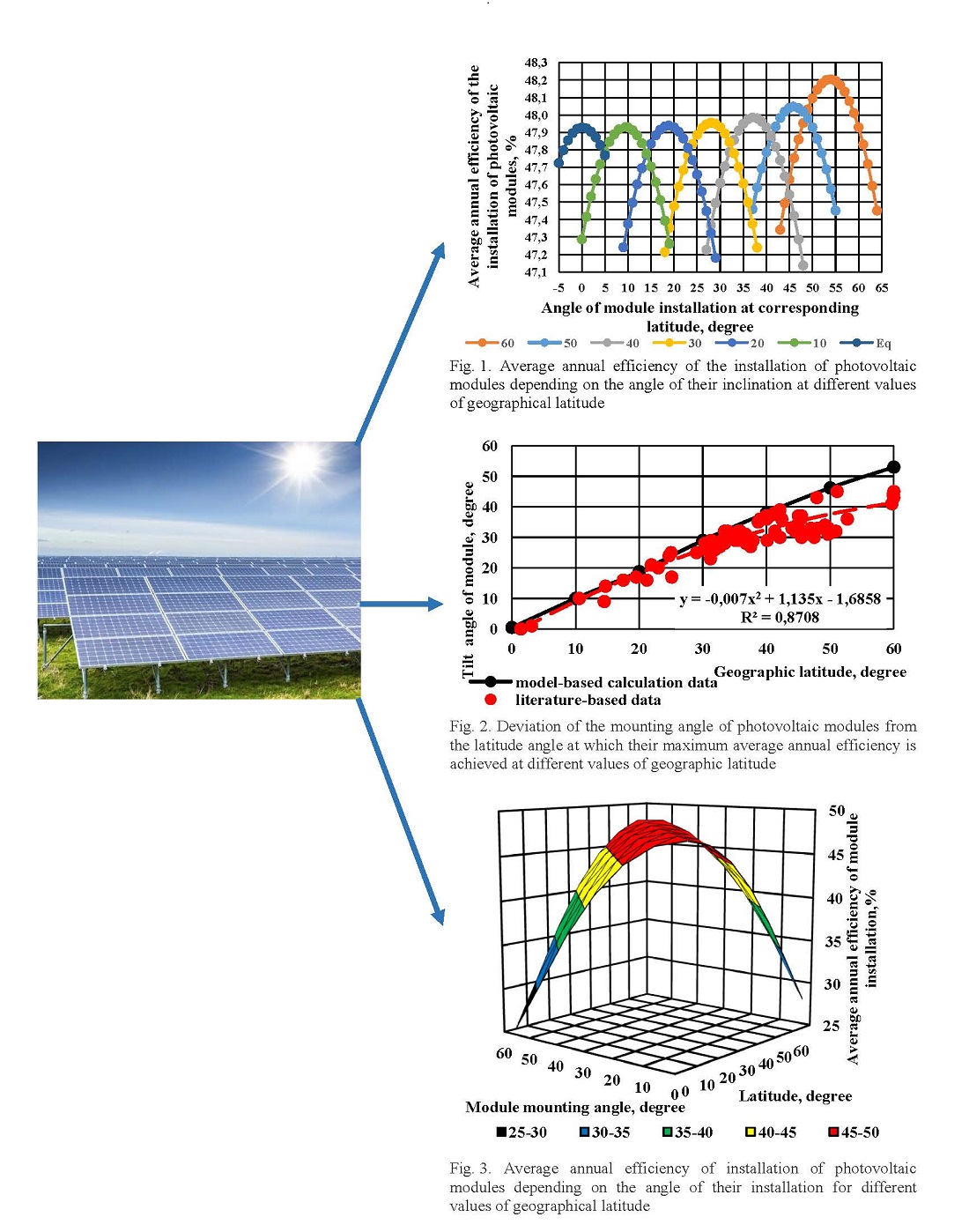Determining the influence of mounting angle on the average annual efficiency of fixed solar photovoltaic modules
DOI:
https://doi.org/10.15587/1729-4061.2024.300485Keywords:
photovoltaic module, angle of incidence of solar rays, efficiency of module installation, geographical latitude, efficiency of photovoltaic modulesAbstract
The object of this study is photovoltaic modules with different options for the angle of their installation to the horizon at different geographical latitudes. The scientific problem to solve was determining the dependence of the average annual efficiency of solar photovoltaic modules on the mounting angle of photovoltaic modules and the value of geographical latitude. It has been proven that the efficiency of installation of solar photovoltaic modules can be increased by reducing the angle of their inclination to the horizon depending on the value of the geographical latitude at which they are installed. The average annual efficiency of photovoltaic modules with different mounting angles to the horizon at different geographical latitudes was determined as the annual weighted average value of the cosine of the angle of incidence of solar rays on the plane of the photovoltaic module. The maximum of the average annual efficiency of photovoltaic modules corresponds to a smaller value of the angle of their installation to the horizon than the value of the geographical latitude. So, with a latitude value of 10°, 20°, 30°, 40°, 50°, and 60°, the mounting angle of photovoltaic modules to the horizon will be 9.5°, 18.8°, 28°, 37°, 45.8°, and 54°, respectively. A dependence was derived that allows determining the mounting angle of photovoltaic modules to the horizon dependent on the value of the geographical latitude at which they are installed. A mathematical expression was also constructed that makes it possible to determine the average annual efficiency of photovoltaic modules depending on the angle of their installation to the horizon for different values of geographic latitude.
The results could be used in calculating the average annual efficiency of photovoltaic modules based on the adjusted values of the angle of their installation to the horizon at different geographical latitudes
References
- Dib, M., Nejmi, A., Ramzi, M. (2020). New auxiliary services system in a transmission substation in the presence of a renewable energy source PV. Materials Today: Proceedings, 27, 3151–3156. https://doi.org/10.1016/j.matpr.2020.03.820
- Satpathy, R. K., Pamuru, V. (2020). Solar PV Power: Design, Manufacturing and Applications from Sand to Systems. Academic Press, 520.
- Umar, S., Waqas, A., Tanveer, W., Shahzad, N., Janjua, A. K., Dehghan, M. et al. (2023). A building integrated solar PV surface-cleaning setup to optimize the electricity output of PV modules in a polluted atmosphere. Renewable Energy, 216, 119122. https://doi.org/10.1016/j.renene.2023.119122
- Lu, Y., Li, G. (2023). Potential application of electrical performance enhancement methods in PV/T module. Energy, 281, 128253. https://doi.org/10.1016/j.energy.2023.128253
- Jha, V. (2023). Generalized modelling of PV module and different PV array configurations under partial shading condition. Sustainable Energy Technologies and Assessments, 56, 103021. https://doi.org/10.1016/j.seta.2023.103021
- Barbosa de Melo, K., Kitayama da Silva, M., Lucas de Souza Silva, J., Costa, T. S., Villalva, M. G. (2022). Study of energy improvement with the insertion of bifacial modules and solar trackers in photovoltaic installations in Brazil. Renewable Energy Focus, 41, 179–187. https://doi.org/10.1016/j.ref.2022.02.005
- Dhimish, M., Ahmad, A., Tyrrell, A. M. (2022). Inequalities in photovoltaics modules reliability: From packaging to PV installation site. Renewable Energy, 192, 805–814. https://doi.org/10.1016/j.renene.2022.04.156
- Peters, I. M., Hauch, J. A., Brabec, C. J. (2022). The role of innovation for economy and sustainability of photovoltaic modules. IScience, 25 (10), 105208. https://doi.org/10.1016/j.isci.2022.105208
- Duffie, J. A., Beckman, W. A. (2013). Solar Engineering of Thermal Processes. John Wiley & Sons, Inc. https://doi.org/10.1002/9781118671603
- Wald, L. (2021). Fundamentals of Solar Radiation. CRC Press, 270. https://doi.org/10.1201/9781003155454
- Grygiel, P., Tarłowski, J., Prześniak-Welenc, M., Łapiński, M., Łubiński, J., Mielewczyk-Gryń, A. et al. (2021). Prototype design and development of low-load-roof photovoltaic modules for applications in on-grid systems. Solar Energy Materials and Solar Cells, 233, 111384. https://doi.org/10.1016/j.solmat.2021.111384
- Winter, C.-J., Sizmann, R. L., Vant-Hull, L. L. (Eds.) (1991). Solar Power Plants. Springer Berlin Heidelberg, 425. https://doi.org/10.1007/978-3-642-61245-9
- Cooper, P. I. (1969). The absorption of radiation in solar stills. Solar Energy, 12 (3), 333–346. https://doi.org/10.1016/0038-092x(69)90047-4
- Liu, R., Liu, Z., Xiong, W., Zhang, L., Zhao, C., Yin, Y. (2024). Performance simulation and optimization of building façade photovoltaic systems under different urban building layouts. Energy, 288, 129708. https://doi.org/10.1016/j.energy.2023.129708
- Ruan, T., Wang, F., Topel, M., Laumert, B., Wang, W. (2024). A new optimal PV installation angle model in high-latitude cold regions based on historical weather big data. Applied Energy, 359, 122690. https://doi.org/10.1016/j.apenergy.2024.122690
- Vasilakopoulou, K., Ulpiani, G., Khan, A., Synnefa, A., Santamouris, M. (2023). Cool roofs boost the energy production of photovoltaics: Investigating the impact of roof albedo on the energy performance of monofacial and bifacial photovoltaic modules. Solar Energy, 265, 111948. https://doi.org/10.1016/j.solener.2023.111948
- Barbón, A., Ghodbane, M., Bayón, L., Said, Z. (2022). A general algorithm for the optimization of photovoltaic modules layout on irregular rooftop shapes. Journal of Cleaner Production, 365, 132774. https://doi.org/10.1016/j.jclepro.2022.132774
- N’Tsoukpoe, K. E. (2022). Effect of orientation and tilt angles of solar collectors on their performance: Analysis of the relevance of general recommendations in the West and Central African context. Scientific African, 15, e01069. https://doi.org/10.1016/j.sciaf.2021.e01069
- Jin, Z., Xu, K., Zhang, Y., Xiao, X., Zhou, J., Long, E. (2017). Installation Optimization on the Tilt and Azimuth Angles of the Solar Heating Collectors for High Altitude Towns in Western Sichuan. Procedia Engineering, 205, 2995–3002. https://doi.org/10.1016/j.proeng.2017.10.225
- Pan, D., Bai, Y., Chang, M., Wang, X., Wang, W. (2022). The technical and economic potential of urban rooftop photovoltaic systems for power generation in Guangzhou, China. Energy and Buildings, 277, 112591. https://doi.org/10.1016/j.enbuild.2022.112591
- Shu, N., Kameda, N., Kishida, Y., Sonoda, H. (2006). Experimental and Theoretical Study on the Optimal Tilt Angle of Photovoltaic Panels. Journal of Asian Architecture and Building Engineering, 5 (2), 399–405. https://doi.org/10.3130/jaabe.5.399
- Buzra, U., Mitrushi, D., Serdari, E., Halili, D., Muda, V. (2022). Fixed and adjusted optimal tilt angle of solar panels in three cities in Albania. Journal of Energy Systems, 6 (2), 153–164. https://doi.org/10.30521/jes.952260
- Liu, B. Y. H., Jordan, R. C. (1963). A rational procedure for predicting the long-term average performance of flat-plate solar-energy collectors : with design data for the U.S., its outlying possessions and Canada. Citeseer.
- Danandeh, M. A., Mousavi G., S. M. (2018). Solar irradiance estimation models and optimum tilt angle approaches: A comparative study. Renewable and Sustainable Energy Reviews, 92, 319–330. https://doi.org/10.1016/j.rser.2018.05.004
- Hafez, A. Z., Soliman, A., El-Metwally, K. A., Ismail, I. M. (2017). Tilt and azimuth angles in solar energy applications – A review. Renewable and Sustainable Energy Reviews, 77, 147–168. https://doi.org/10.1016/j.rser.2017.03.131
- Santos-Martin, D., Lemon, S. (2015). SoL – A PV generation model for grid integration analysis in distribution networks. Solar Energy, 120, 549–564. https://doi.org/10.1016/j.solener.2015.07.052
- Jacobson, M. Z., Jadhav, V. (2018). World estimates of PV optimal tilt angles and ratios of sunlight incident upon tilted and tracked PV panels relative to horizontal panels. Solar Energy, 169, 55–66. https://doi.org/10.1016/j.solener.2018.04.030
- Breyer, C., Schmid, J. (2010). Population Density and Area weighted Solar Irradiation: global Overview on Solar Resource Conditions for fixed tilted, 1-axis and 2-axes PV Systems. In 25th European Photovoltaic Solar Energy Conference and Exhibition. Valencia, 4692–4709. https://doi.org/10.4229/25thEUPVSEC2010-4BV.1.91
- Nicolás-Martín, C., Santos-Martín, D., Chinchilla-Sánchez, M., Lemon, S. (2020). A global annual optimum tilt angle model for photovoltaic generation to use in the absence of local meteorological data. Renewable Energy, 161, 722–735. https://doi.org/10.1016/j.renene.2020.07.098
- Golub, G., Tsyvenkova, N., Yaremenko, O., Marus, O., Omarov, I., Нolubenko, A. (2023). Determining the efficiency of installing fixed solar photovoltaic modules and modules with different tracking options. Eastern-European Journal of Enterprise Technologies, 4 (8 (124)), 15–25. https://doi.org/10.15587/1729-4061.2023.286464
- Nfaoui, M., El-Hami, K. (2018). Extracting the maximum energy from solar panels. Energy Reports, 4, 536–545. https://doi.org/10.1016/j.egyr.2018.05.002
- Khorasanizadeh, H., Mohammadi, K., Mostafaeipour, A. (2014). Establishing a diffuse solar radiation model for determining the optimum tilt angle of solar surfaces in Tabass, Iran. Energy Conversion and Management, 78, 805–814. https://doi.org/10.1016/j.enconman.2013.11.048
- Rowlands, I. H., Kemery, B. P., Beausoleil-Morrison, I. (2011). Optimal solar-PV tilt angle and azimuth: An Ontario (Canada) case-study. Energy Policy, 39 (3), 1397–1409. https://doi.org/10.1016/j.enpol.2010.12.012
- Prunier, Y., Chuet, D., Nicolay, S., Hamon, G., Darnon, M. (2023). Optimization of photovoltaic panel tilt angle for short periods of time or multiple reorientations. Energy Conversion and Management: X, 20, 100417. https://doi.org/10.1016/j.ecmx.2023.100417

Downloads
Published
How to Cite
Issue
Section
License
Copyright (c) 2024 Gennadii Golub, Nataliya Tsyvenkova, Volodymyr Nadykto, Oleh Marus, Oksana Yaremenko, Ivan Omarov, Anna Нolubenko, Olena Sukmaniuk, Oleksandr Medvedskyi

This work is licensed under a Creative Commons Attribution 4.0 International License.
The consolidation and conditions for the transfer of copyright (identification of authorship) is carried out in the License Agreement. In particular, the authors reserve the right to the authorship of their manuscript and transfer the first publication of this work to the journal under the terms of the Creative Commons CC BY license. At the same time, they have the right to conclude on their own additional agreements concerning the non-exclusive distribution of the work in the form in which it was published by this journal, but provided that the link to the first publication of the article in this journal is preserved.
A license agreement is a document in which the author warrants that he/she owns all copyright for the work (manuscript, article, etc.).
The authors, signing the License Agreement with TECHNOLOGY CENTER PC, have all rights to the further use of their work, provided that they link to our edition in which the work was published.
According to the terms of the License Agreement, the Publisher TECHNOLOGY CENTER PC does not take away your copyrights and receives permission from the authors to use and dissemination of the publication through the world's scientific resources (own electronic resources, scientometric databases, repositories, libraries, etc.).
In the absence of a signed License Agreement or in the absence of this agreement of identifiers allowing to identify the identity of the author, the editors have no right to work with the manuscript.
It is important to remember that there is another type of agreement between authors and publishers – when copyright is transferred from the authors to the publisher. In this case, the authors lose ownership of their work and may not use it in any way.








